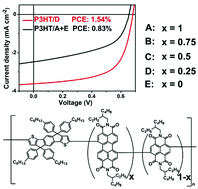Perylene and naphthalene diimide polymers for all-polymer solar cells: a comparative study of chemical copolymerization and physical blend†
Abstract
Five copolymers, having 4,4,9,9-tetrakis(4-hexylphenyl)-indaceno[1,2-b:5,6-b′]-dithiophene as a donor unit, and perylene diimide (PDI) and/or naphthalene diimide (NDI) as acceptor moieties, were synthesized by Stille coupling copolymerization, and used as electron acceptors in solution-processed polymer solar cells (PSCs). All five copolymers exhibited broad absorption in the region of 300–800 nm. The LUMO energy level of the resulting copolymers was from −3.90 to −3.77 eV and the HOMO energy level had little variation from −5.65 to −5.57 eV. Among binary blend PSCs using P3HT as a donor and these polymers as acceptors, PPDI25-co-NDI75-based devices (P3HT : PPDI25-co-NDI75 = 3 : 1, w/w) yielded the best power conversion efficiency (PCE) of up to 1.54%. Among ternary blend PSCs using P3HT as a donor and PDI polymer PPDI100 and NDI polymer PNDI100 as coacceptors, the P3HT : PPDI100 : PNDI100 (3 : 0.25 : 0.75, w/w) ternary blend afforded the best PCE of 0.83%. All ternary blends based on P3HT : PPDI100 : PNDI100 showed decreased VOC, JSC, FF and PCE compared to the corresponding binary blends based on P3HT : PPDI-co-NDI.


 Please wait while we load your content...
Please wait while we load your content...